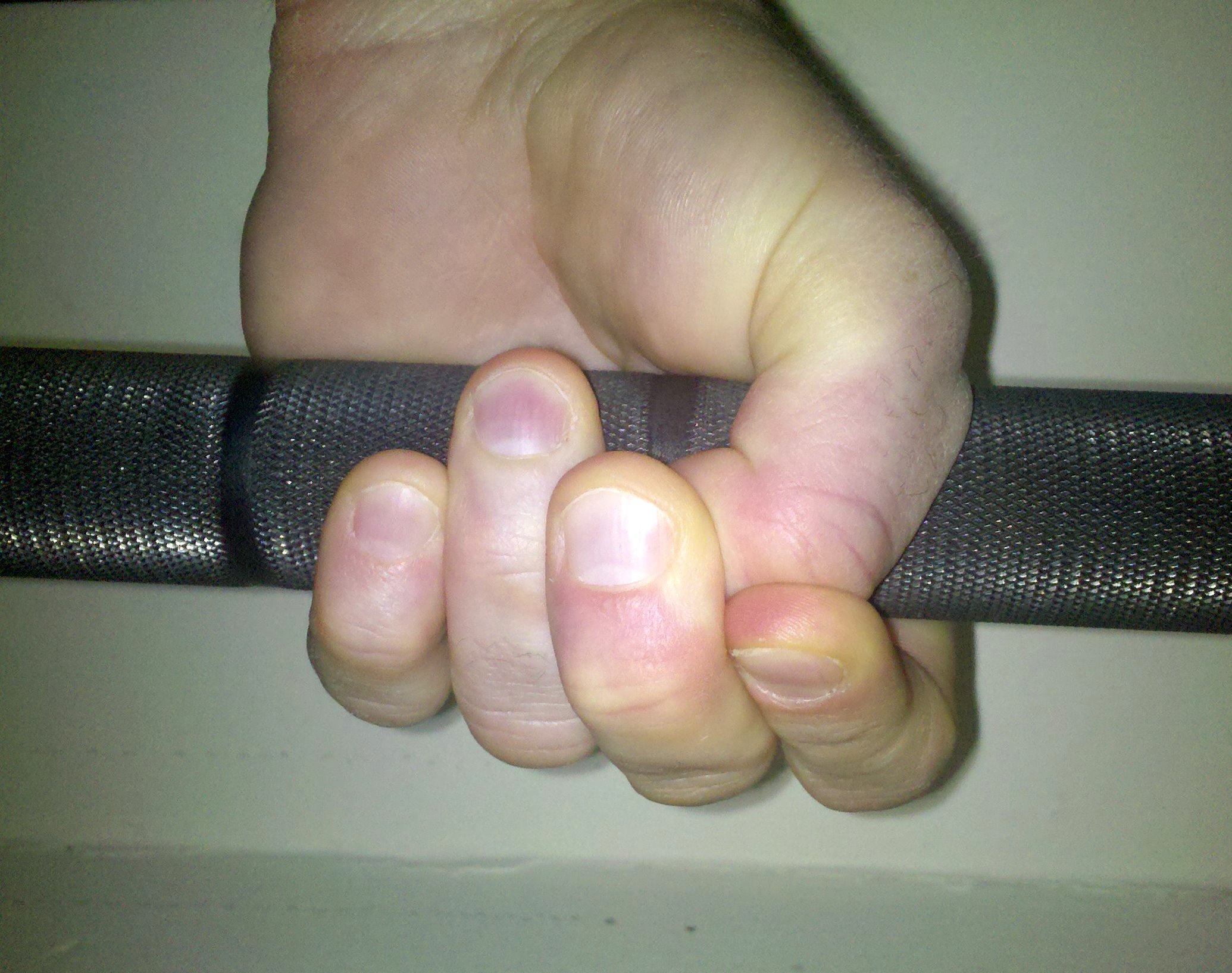What about ‘hook grip’ Deadlifts?

If there’s ever a culprit for the biggest limiting factor when it comes to the deadlift, it’s your grip – or grip strength. Granted, this only really plays a significant role when you reach reasonable strength levels (1.5 + times bodyweight) but the standard, double overhand grip with the thumbs around the bar only stays loyal to you for so long. Once it lags behind your glutes, hamstrings and spinal erectors in terms of strength, it’s time to find a ‘void-filler’.
There’s generally three contenders: The mixed grip, lifting straps and the hook grip. The mixed grip is used most; one hand is supinated, the other is pronated (traditional grip). While the mixed grip seems mighty fine at first glance, when the ante is upped and you use heavy enough loads – over 2 times bodyweight – you’ll find some obstacles.
The asymmetric grip can lead to muscular imbalances – as if we don’t have enough of these already! And I know the imbalance ‘risk’ is only slight, but once things get serious (lots of experience deadlifting/using impressive loads), it certainly becomes more apparent. Try deadlifting over two times your bodyweight with the mixed grip and see if you don’t feel any spinal torsion. Symmetrical arms just feels far better when you get in the realm of over 2 times bodyweight.

(crossfitinvictus.com)
The bigger risk of the mixed grip is the potential to tear your beloved guns (biceps). What would you do then? Those tight shirts will have to collect dust in the wardrobe! But the reality is, many people have torn their biceps while pulling with a mixed grip. This isn’t to say it will happen. But it can. The safety net here is keeping the arms fully extended – even more so the supinated arm. It makes sense, the load will be multiple times greater than you could ever curl; your tiny biceps cannot possibly stay flexed under such weight and will thus be forced into extension. In other words, over-stretched/torn.
Strap up
Another very viable option is lifting straps. These bulletproof your grip to the point where grip strength will almost never be the limiting factor. And of course, you can maintain symmetrical arms. Obviously you have to actually have your own straps and bring them with you to the gym. We’ve all seen those using straps as though they’re a fashion accessory. They strap up as soon as they enter the establishment. They use straps to hold on to the calf machine handles. Rumour has it they keep them under their pillow at night to make better gains.
lifting straps
The downside to chronic strap use is much like chronic pre workout use, dependency. It’s just easier to use straps even on lighter sets. And accordingly, your grip stagnates and becomes even more of a weak link than it once was.
The solution? Use straps when you absolutely have to. It’s that simple.
A right hook
Finally we arrive at the third option, the hook grip. This is slightly ‘underground’ and somewhat rare – particularly in mainstream gyms. Although among powerlifting and Olympic lifting circles, it’s common knowledge. The great thing about the hook grip is you need no equipment and it utilises symmetrical arms.

(crossfitfbo.com) – the thumb sits INSIDE the fingers
From a personal anecdote, I had known about the hook grip for a long time but shied away from trying it as I had heard all the horror stories of people sacrificing their thumbs in the process. But I love an experiment and began using it when I just couldn’t hold the bar without bar-roll (once I go much over 300 lbs) and found it works beautifully! Also, the ‘thumb discomfort’ is way over-hyped. The bar feels solid in your hands and if you like a bit of fun, you can trick people into thinking you’re pulling massive weights with a standard double overhand grip. Not that I’d ever do such a thing.
In summary, the hook grip has been a great addition to my workout toolbox. I like it far more than the mixed grip and I don’t have to lug straps around with me. Winning.
Have you used the hook grip? Are you a fan? Which of the three gets your vote?
It’s the hook grip for me.
Categories
JR @ Straight-Talking-Fitness View All
The 'brains' behind StraightTalkingFitness, a site all about discovery that leads to strength in all formats; fitness, mental, emotional and spiritual. Everything starts from within and projects outwards. Master the body, master anything and everything.


I’m nowhere near deadlifting 1.5 – 2x my body weight, but with a barbell much past 200 pounds, I do tend to favor a mixed grip. At such a modest weight, from what I gather in your article, this shouldn’t be a problem. Assuming I ever am able to lift somewhere in the neighborhood of 300+ pounds, I’d certainly be willing to consider the hook grip.
Just get in the habit of keeping your arms fully extended and the mixed grip should be fine. And try to alternate which hand goes under and over from set to set. That just further insures you against possible imbalances.
Good idea. Thanks.
I’ll try it this week. I’ve always liked the mixed grip because I can mice more weight. I prefer no straps on deads for the reason you mention. It’s time to try mixed because my weight is going up and I’m risking a tear.
It’s a strange one. Many people have used the mixed grip for years without any trouble. I just like the feel of symmetrical arms. I guess it’s a case of giving each one a fair trial with a decent amount of weight.
I LOVE deadlifting though! Haha. Thanks for commenting 🙂
Hey there! Great read, I was lucky enough to have a trainer a few years ago who was an advocate for the book grip and I’ve been using it ever since. I noticed a significant difference to my lifting performance and my overall grip strength has improved dramatically!
Hey Hannah, nice to see I’m not the only ‘weirdo’ haha. I just like the symmetrical nature of it. How do your thumbs find it over a certain weight? Nice blog BTW.
Hey there! Thanks. I find my thumbs hold up pretty well overall, but I’m sorta floating around that 110kg mark for deads. So it’s not super heavy, but I find it way more comfortable than lifting straps.
What is that relative to your bodyweight? And I’ve never used lifting straps, never seen the need.
Hey there it’s a bit over 1.5 my body weight. I’m looking to increase up 120 – 125 which will be double.
Nice! Getting over double bodyweight will be decent indeed. I’m close to 2.5 for a 1RM.
That’s awesome! I might get there… One day. Haha
For a female, that would be probably the equivalent to 3x for a guy!